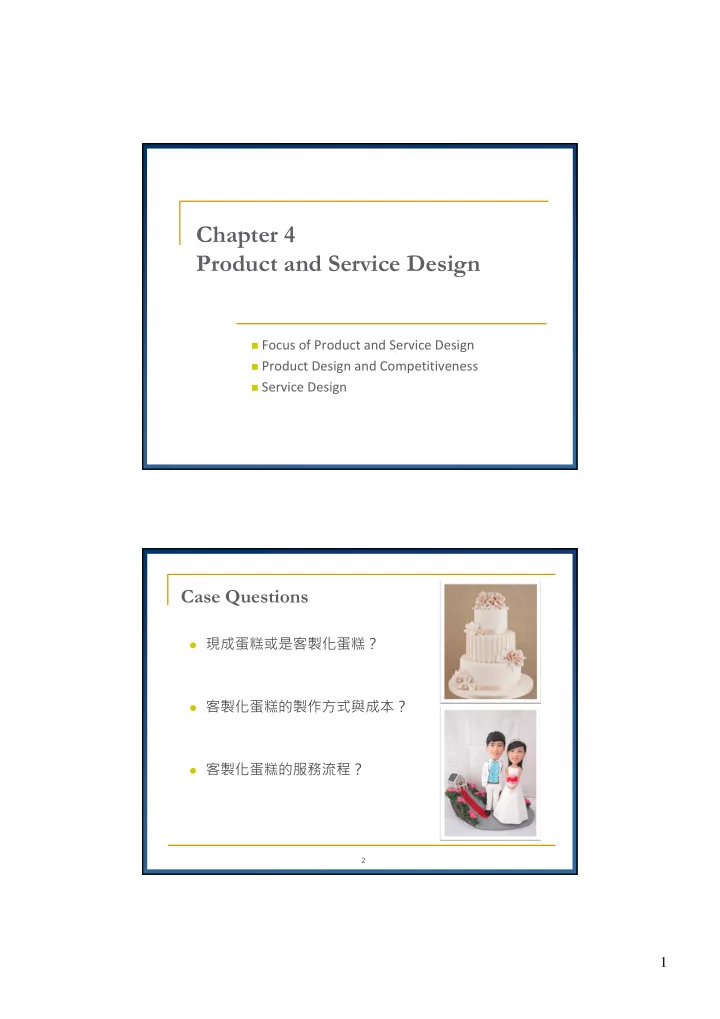

Chapter 4 Product and Service Design Focus of Product and Service Design Product Design and Competitiveness Service Design Case Questions 現成蛋糕或是客製化蛋糕? 客製化蛋糕的製作方式與成本? 客製化蛋糕的服務流程? 2 1
Main Focus Customer satisfaction: 了解並符合目標顧客的需求 Secondary focus Function of product/service Cost/Profit Quality Appearance Ease of production/assembly Ease of maintenance/service Product and service design—or redesign—should be closely tied to an organization’s strategy 4 What Does Product or Service Design Do? 1. Translate customer wants and needs into product and service requirements 2. Refine existing products and services 3. Develop new products and services 4. Formulate quality goals 5. Formulate cost targets 6. Construct and test prototypes 7. Document specifications 食譜:能做出相同的料理 8. Translate into process specifications. 5 2
Idea Generation 點子哪裡來? Research and Development R&D Basic Research Applied Research Development 服務業缺乏專利保護 Reverse Engineering Dismantling and inspecting a competitor’s product to learn and to discover possible improvements. Original Design Manufacturer ODM 代工 7 Product Standardization 單一標準規格? Advantages: Fewer parts to deal with in inventory and manufacturing Reduced design costs and time Quality is more consistent Opportunities for long production runs and automation Disadvantages Decreased variety results in less consumer appeal High cost of design changes increases resistance to improvements 8 3
Mass Customization: A strategy of producing standardized goods or services, but incorporating some degree of customization. 半自助旅遊 Cultural Factors Canon G8, Hyundai Atos 9 Design for Production 將好的設計製造出來 Concurrent Engineering bringing engineering design and manufacturing personnel together early in the design phase. Quality Function Deployment: integrate the voice of the customers into product development. 10 4
Design For Manufacturing and Assembly 簡化產品設計或零組件數量 以降低成本或改善品質 商業午餐 12 Value Analysis/Value Engineering Examination of the function of parts and materials to reduce costs of order qualifiers and order winners 在不影響功能的前提下,簡化產品設計與製程以 降低成本 Is the item necessary? Could another material be used instead? Can specifications be less stringent? Can two or more parts be combined? Can packaging be improved to save cost? 採購運用VA以降低採購成本 研發運用VE以避免增加製造成本 13 5
Design for Logistics 14 Design a Service is Different Tangible and intangible 無形性 Customer Involvement – created and delivered at the same time 同時性 Services cannot be inventoried 易滅性 Services highly visible to customers (front office) Services have low barrier to entry (competition) Location is important to service design Range of service systems 異質性 Demand variability 15 6
Designing Service Package Supporting facility: physical resources that must be in place before a service can be sold 建築外觀、內部裝潢 Facilitating goods: material consumed by the service process 餐盤、食材、商品 Information: operations data or information to enable efficient and customized service 庫存紀錄、教材 Explicit services: benefits readily observable 停車場、網頁 Implicit services: psychological benefits which the consumer may sense only vaguely 服務效率與態度 16 A Service Blueprint for a Restaurant 顧客到達 顧客離開 用餐 Interactive F Line 前場 訂位 入座點菜 上菜 結帳 Line of Visibility F F 通知廚房 烹飪 準備帳單 後場 Line of Support 準備材料 Fail ‐ safing = pokayokes service encounter moments of truth 18 7
Guidelines for Successful Service Design 1. Define the service package in detail 2. Focus on customer’s perspective (expectation and perception) 3. Consider image of the service package 4. Recognize that designer’s perspective is different from the customer’s perspective 5. Make sure that managers are involved 6. Define quality for tangible and intangibles elements 7. Make sure that recruitment, training, and rewards are consistent with service expectations 8. Establish procedures to handle exceptions 9. Establish systems to monitor service 19 Conclusion 產品的設計直接決定 企業競爭力 產品設計要面對顧客需求、 市場競爭、技術演進 成功的產品設計考慮到對製造與儲運的影響,以及 顧客使用便利性與售後服務 無形內容與顧客在場影響服務業的產品設計 服務業的員工招募與訓練須符合產品設計 20 8
Recommend
More recommend